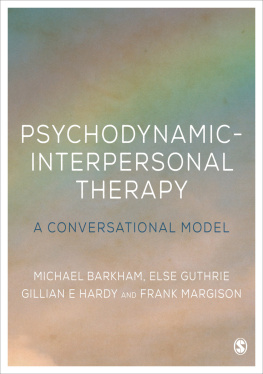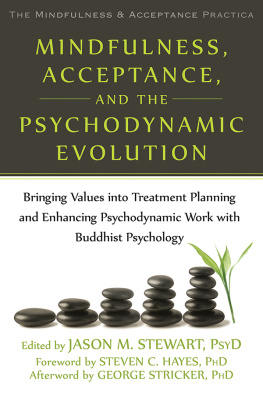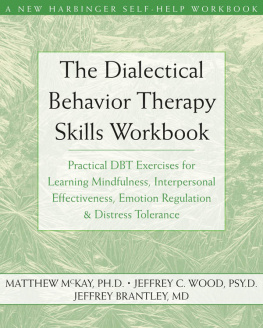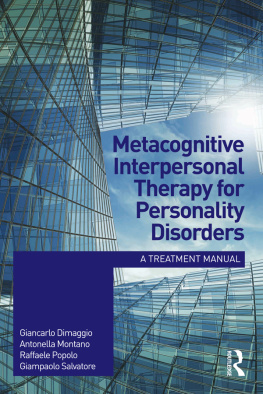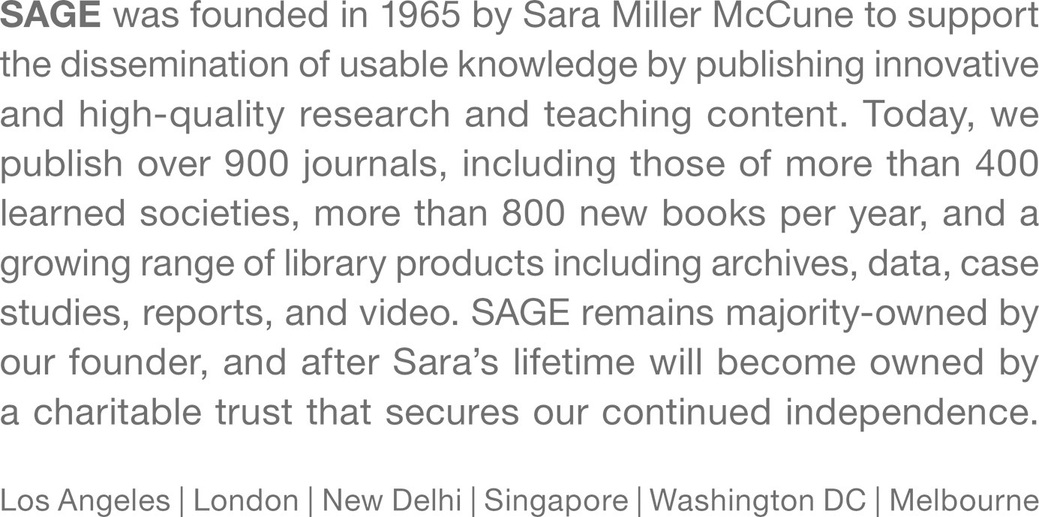Psychodynamic-Interpersonal Therapy
Psychodynamic-Interpersonal Therapy
A Conversational Model
- Michael Barkham
- Else Guthrie
- Gillian E Hardy
- and Frank Margison
SAGE Publications Ltd
1 Olivers Yard
55 City Road
London EC1Y 1SP
SAGE Publications Inc.
2455 Teller Road
Thousand Oaks, California 91320
SAGE Publications India Pvt Ltd
B 1/I 1 Mohan Cooperative Industrial Area
Mathura Road
New Delhi 110 044
SAGE Publications Asia-Pacific Pte Ltd
3 Church Street
#10-04 Samsung Hub
Singapore 049483
Michael Barkham, Else Guthrie, Gillian E. Hardy and Frank Margison 2017
First published 2017
Apart from any fair dealing for the purposes of research or private study, or criticism or review, as permitted under the Copyright, Designs and Patents Act, 1988, this publication may be reproduced, stored or transmitted in any form, or by any means, only with the prior permission in writing of the publishers, or in the case of reprographic reproduction, in accordance with the terms of licences issued by the Copyright Licensing Agency. Enquiries concerning reproduction outside those terms should be sent to the publishers.
Library of Congress Control Number: 2016938549
British Library Cataloguing in Publication data
A catalogue record for this book is available from the British Library
ISBN 978-0-7619-5662-4
ISBN 978-0-7619-5663-1 (pbk)
Editor: Susannah Trefgarne
Editorial assistant: Edward Coats
Production editor: Rachel Burrows
Copyeditor: Kate Campbell
Proofreader: Neil Dowden
Indexer: Martin Hargreaves
Marketing manager: Camille Richmond
Cover design: Lisa Harper-Wells
Typeset by: C&M Digitals (P) Ltd, Chennai, India
Printed and bound by CPI Group (UK) Ltd, Croydon, CR0 4YY
This book is dedicated to the memory of Dr Robert F. Hobson MD with gratitude for his inspiring vision and teaching.
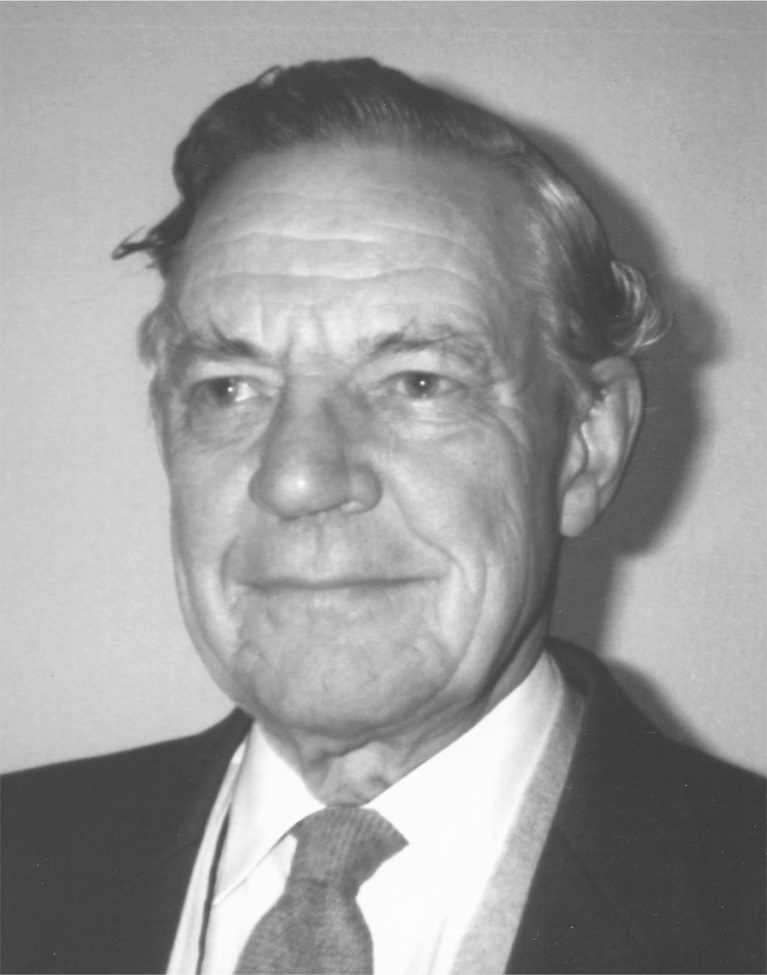
19201999
List of Tables
About the Authors
Michael Barkhamis Professor of Clinical Psychology and Director of the Centre for Psychological Services Research at the University of Sheffield. He was Joint Editor of the
British Journal of Clinical Psychology (20042011) and is a Fellow of the British Psychological Society. He was the international Vice-President for the UK chapter of the Society for Psychotherapy Research and, with colleagues, developed the family of CORE outcome measures widely used in practice-based evidence. He has led on several of the process-outcome studies in Sheffield and Leeds.Else Guthrieis a Consultant in Psychological Medicine and Honorary Professor of Psychological Medicine and Medical Psychotherapy at the University of Manchester. She runs a busy liaison psychiatry service in Manchester and is a clinician and researcher. She has conducted many of the research studies on PI therapy in Manchester, including work on self-harm and persistent physical symptoms. Her other research interests include the interplay between physical and psychological disorders.Gillian E. Hardyis Professor of Clinical Psychology and Director of the Clinical Psychology Unit at the University of Sheffield. She was Joint Editor of the
British Journal of Clinical Psychology (20042011), and Associate Editor of the
British Journal of Medical Psychology (20002005). She worked as a therapist/researcher on the Sheffield and Leeds research psychotherapy projects and has a particular interest in psychotherapy process research and attachment theory.Frank Margisonis a consultant psychiatrist in psychotherapy and general adult psychiatry working in Manchester. From 1978 he worked on the development of the Conversational Model of psychotherapy with Bob Hobson and led on developing teaching methods. His psychotherapy research apart from PI therapy has been in assessing client change using the CORE measure. He was UK Vice-President of the Society for Psychotherapy Research and was joint editor of the
British Journal of Medical Psychology.
Preface
This book has been through several iterations prior to publication. We began with an attempt to write a definitive Handbook of Psychodynamic Interpersonal Therapy, a type of therapy also known as the Conversational Model. After a while we shifted focus and we have developed a much briefer book that focuses mainly on the very pragmatic aspects of doing therapy in this way. In many ways this goes back to the roots of the model in the very practical applications pioneered in the United Kingdom by Robert Hobson.
The opening chapter () provides a brief introduction to how this model of psychotherapy developed, and links to other books on how it can be applied in the long-term therapy of serious, long-term personality difficulties (through the work of Russell Meares and colleagues in Australia). The chapter also introduces the theoretical basis of the model in outline.
Our original intention of summarising in detail the many research studies of this model has crystallised into two chapters (), the first of which summarise briefly the evidence that demonstrates that this approach is effective, and then a chapter on the many process research studies that together tell a story about how this approach may be effective.
The bulk of the book comprises six chapters () that constitute a manual for a generic form of the Conversational Model. It is written to be suitable for beginners with little or no background in psychotherapy or counselling and can form the foundation for a teaching programme.
cover introductory, intermediate and advanced skills. The introductory skills can stand alone as a generic approach to helping patients or clients to focus on important feelings, while the intermediate and advanced skills build incrementally to cover those skills needed to practise this model of therapy, especially in its briefer forms.
develop the skills as they emerge in the beginning, middle and end of a therapy with some extended examples of an anonymised therapy based on actual sessions with Robert Hobson. These are not intended as exemplars of perfect practice, but rather as therapy conducted in real life, warts and all. Hobson emphasised the importance of learning from and acknowledging mistakes and we have tried to represent a realistic approach to conducting a form of therapy that is very easy to learn in its basics, but a life-long task to deliver at its best.
The book is also intended for those who already have a solid background in therapy or counselling who want to develop skills in this particular model. Some of the basics of how to start a session may seem redundant, but those aspects are arranged to lead logically into the fundamental skills and principles of the model.

